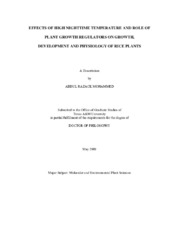| dc.description.abstract | Seasonally high nighttime temperatures (HNT) along the United States Gulf
Coast and in regions of similar climate, during the critical stages of development, could
reduce rice yield and quality. To study the effects of HNT on plant physiology, a method
for applying a controlled heating treatment to plant canopies was developed using
overhead infrared heaters, which are relatively inexpensive and are accurate, precise and
reliable in rapidly controlling the temperature. The apparatus successfully maintained air
temperatures within the set points plus/minus 0.5 degrees C, and was used for all the experiments. Several
experiments were conducted to determine the response of various physiological
parameters during and following exposure of rice plants to HNT (32 degrees C) or ambient
nighttime temperature (ANT) (27 degrees C) starting from 2000 h until 0600 h, and with or
without plant growth regulator treatments. The plant growth regulator treatments
included alpha-tocopherol (vitamin E), glycine betaine (GB), and salicylic acid (SA), which
play different roles in inducing thermo-tolerance in plants.
High nighttime temperature had no effect on plant height, number of tillers and
panicles, or rice net leaf photosynthetic rates. However, HNT increased leaf respiration (dark respiration in the night) (21%) and decreased membrane thermo-stability (60%),
pollen germination (20%), spikelet fertility (18% as a % of total spikelets), grain length
(2%), and grain width (2%). The HNT also hastened plant development. The
combinations of these effects decreased rice yield by 90%. Moreover, under HNT, there
were decreases in leaf chlorophyll concentration (7%) and nitrogen concentration (18%).
Application of GB and SA increased total antioxidant capacity of the rice plants by 17%,
thereby decreasing the leaf respiration rates, increasing membrane thermo-stability,
pollen germination, and spikelet fertility, thus increasing the yield. High nighttime
temperature decreased leaf starch concentration (14%), grain total nonstructural
carbohydrate (TNC) concentration (9%), and grain extractable invertase activity (20%).
Vitamin E- or GB-treated plants had greater grain soluble-sugar concentrations, whereas
SA-treated plants had greater leaf soluble-sugar concentrations and lower grain TNC
concentrations. Invertase activity was shown to be not rate limiting or required for
sucrose degradation for starch synthesis in grain of 'Cocodrie' rice under short-term high
nighttime temperatures exposures during grain filling.
In conclusion, HNT decreased rice yield by increasing plant respiration, rate of crop
development, and decreasing membrane thermo-stability, pollen germination, spikelet
fertility and grain dimensions. Exogenous application of GB and SA increased yields
under HNT, possibly acting through increased antioxidant levels, which might have
protected the membranes and enzymes against heat-induced ROS-mediated degradation. | en |


